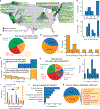Data science and its future in large neuroscience collaborations
- PMID: 39326391
- PMCID: PMC11632705
- DOI: 10.1016/j.neuron.2024.08.017
Data science and its future in large neuroscience collaborations
Abstract
Collaborative neuroscience requires systematic data management and analysis. How this is best done in practice remains unclear. Based on a survey across collaborative neuroscience projects, we document the current state of the art focusing on data integration, sharing, and researcher training. We propose best practices and list actions and policies to attain these goals.
Copyright © 2024 Elsevier Inc. All rights reserved.
Conflict of interest statement
Declaration of interests The authors declare no competing interests.
Figures

Update of
-
Data science and its future in large neuroscience collaborations.bioRxiv [Preprint]. 2024 Mar 25:2024.03.20.585936. doi: 10.1101/2024.03.20.585936. bioRxiv. 2024. Update in: Neuron. 2024 Sep 25;112(18):3007-3012. doi: 10.1016/j.neuron.2024.08.017. PMID: 38585895 Free PMC article. Updated. Preprint.
References
-
- National Research Council (2009). A New Biology for the 21st Century: Ensuring the United States Leads the Coming Biology Revolution (National Academies Press; ). http://www.ncbi.nlm.nih.gov/books/NBK32509/. - PubMed
-
- BRAIN Initiative Working Group (2014). Brain 2025: A Scientific Vision. https://braininitiative.nih.gov/vision/nih-brain-initiative-reports/brai....
-
- The International Brain Laboratory, Bonacchi N, Chapuis G, Churchland A, Harris KD, Hunter M, Rossant C, Sasaki M, Shen S, Steinmetz NA, et al. (2020). Data architecture for a large-scale neuroscience collaboration. Preprint at bioRxiv. 10.1101/827873. - DOI
-
- Saunders JL (2022). Decentralized Infrastructure for (Neuro)science. Preprint at arXiv. 10.48550/arXiv.2209.07493. - DOI
-
- Bacchelli A, and Bird C (2013). Expectations, outcomes, and challenges of modern code review. In 2013 35th International Conference on Software Engineering (ICSE) (IEEE), pp. 712–721. 10.1109/ICSE.2013.6606617. - DOI
MeSH terms
Grants and funding
LinkOut - more resources
Full Text Sources

